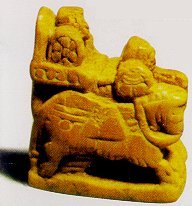Archaeological findings
Two nice collections :
Several controvertial pieces:
Some famous sets :
Other pages :
-
The terracotta figures from Northern India
-
The Butrint piece
-
Chess representation in Angkor temples in Cambodia
-
The oldest Janggi (Korean Chess) known pieces, found in Mado shipwreck N°3
If texts constitute the main sources for Chess history, archaeological findings made available through the world are from the first importance.
Unfortunately, they are in a rather limited number mainly for two reasons:
1) the materials used for Chess and other games can not be always conserved. Boards may have been drawn or dug on the ground or on perishable supports. Wood is also short-lived, especially in humid countries. Only in very specific conditions, wooden game pieces that can be identified have a chance to be discovered. As far as metals are concerned, pieces in token shape, as for Xiangqi, could have been mistaken for coins. That is the main reason to explain why only almost complete sets have been found for old Xiangqi: incomplete ones could have been taken to mere coins.
2) the important countries or regions for seminal Chess are, alas, victims of modern wars or major instabilities : Afghanistan, Tajikistan, Kashmir are very difficult areas for archaeological missions. Another region which could be of importance to understand the diffusion in Asia is Indochina. It can be imagined how it should be difficult to dig in Cambodia or Vietnam nowadays.
|
Estimated Date |
Place of discovery |
Game |
Museum |
|
2nd century AD |
Dalverzin-Tepe, Southern Uzbekistan |
? |
Chamra Institute of scientific art, Tashkent |
|
Two small ivory figures of Indian origin (?) : an Elephant and a Zebu-like Bull |
|||
|
from 2nd to 5th century |
Northern India, Kanauj, Ahicchatra, Pâtaliputra |
? |
Kept in museums in India |
|
Several terracotta figures, in form of warriors, elephants, horses and chariots. Their use as chessmen has not been proved yet. |
|||
|
Before 628 ? (by comparison with sculpture from Sassanian period) |
Persian origin, purchased in Bagdad, Irak |
Chatrang (tbc) |
Metropolitan Museum of Art, New York |
|
Elephant in carved stone (dolomite). Its chess piece nature is contested by some historians |
|||
|
Early 6th century |
Afghanistan or Northern India |
? |
Private collection, Germany |
|
Brownish terracotta Knight. Its design bears several similarities with some Afrasiab pieces |
|||
|
Around 761 (because a coin so dated belongs to the same layer) |
Afrasiab, near Samarkand, Uzbekistan / Tajikistan |
Uzbekistan State Museum, Samarkand |
|
|
7 ivory men : King, Vizir, Elephant, 2 Knights, Chariot and Pawn. Several isolated pieces have been unearthed which are alike. |
|||
|
6th-8th century? |
Private collection |
||
|
5 stone men : 1 King or Vizir, 2 Elephants, 1 Knight, 1 Chariot. |
|||
|
8th-10th century |
Belaia Vezha, on the Don river, South of Russia |
Shatranj |
Hermitage Museum, St Petersburg, Russia |
|
An ivory Elephant |
|||
|
9th-10th century |
Nishapur, Iran |
Shatranj |
Metropolitan Museum of Art, New York |
|
King, Vizir, Knight, Elephant, Rook having an Arabic abstract pattern. One side stained dark green. Elephants have two small tusks on the top. |
|||
|
End of 9th or beginning of 10th |
San Genadio, Leon, Spain |
Chess |
Monastery of Santiago de Peñalba |
|
Mozarab chess pieces. Ivory. First Chess piece known in Europe |
|||
|
Late 10th century |
Venafro, Campania, Italy |
Chess |
Museo archeologico di Napoli (Italy) |
|
Chess set, bone with ivory topping |
|||
|
1008-1010 |
Paladru Lake |
Chess |
Colletière, Isère, France |
|
Queen, Bishop and Rook in hazeltree wood or bone |
|||
|
978-1070 |
Pineuilh |
Chess |
Pineuilh, St Foy la Grande, France |
|
A Rook (deer bone) and a kneeled piece |
|||
|
1059 |
In the Kôfukuji at Nara |
Nara, Japan (?) |
|
|
16 pieces, same shape as modern pieces in Hinoki wood (Japanese cypress). Drunk Elephant is thought to be within those pieces. |
|||
|
1068-1071 |
Ager, Catalonia, Spain |
Chess |
Museum de Lleida (Lerida) Dociesa i Comarcal (Spain) |
|
Mozarab chess set, rock-crystal |
|||
|
1080-1090, probably made in Salerne, south of Italy |
From the St Denis Treasure, origin unknown. Often wrongly named "The Charlemagne set". |
Chess |
Bibliothèque Nationale, Paris |
|
Carved pieces in elephant ivory: 2 Kings, 2 Queens, 4 Elephants, 4 Knights, 3 Chariots (Rooks), 1 Foot Soldier. |
|||
|
Beginning of 12th century |
Scandinavian or German
origin |
Chess |
Musée du Noyonnais, Noyon, France |
|
Chess set, deer bone |
|||
|
1102-1106 (Chongning era) during Northern Song Dynasty (960-1126) |
1)Near Anxi in Jiangxi province |
Beijing (?) |
|
|
1)32 copper pieces: 2 Generals, 4
Ministers (differentiated through slightly
different characters), 4 Chariots, 4 Horses, 4
Elephants, 4 Cannons, 10 Soldiers. Disks red and
black. Characters in one side and pictures on
the other. |
|||
|
About 1150 and probably from Trondheim or other Scandinavian town |
Isle of Lewis, Outer Hebrides, Scotland |
Chess |
British Museum, London & National Museums of Scotland, Edinburgh |
|
93 carved pieces: 8 Kings, 8 Queens, 16 Bishops, 15 Knights, 12 Warders (Rooks), 19 Pawns, 14 plain disks, 1 belt buckle. Some are stained red. Made in walrus tusk but few in whale tooth. |
|||
|
Before 1200 |
Angkor, Cambodia |
||
|
Sculptures on reliefs |
|||

Rukh (Chariot) in ivory from
Afrasiab,
about 7th/8th century, Uzbekistan State Museum,
Samarkand
(from "Roi des jeux, jeu des rois, les échecs",
Jean-Michel Péchiné, Gallimard)

























